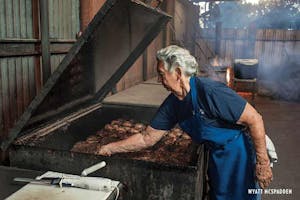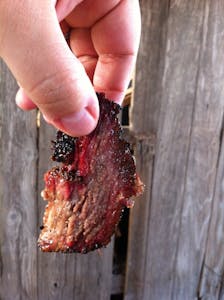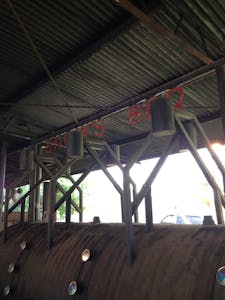 Pitmaster: Snow’s BBQ; opened in 2003.
Pitmaster: Snow’s BBQ; opened in 2003.
Age: 78
Smoker: A steel smoker with an offset firebox for briskets, a direct heat pit for everything else.
Wood: Post Oak
Tootsie took her lunch break to talk with me while working her day job with the Giddings school district. After Texas Monthly named Snow’s BBQ the best barbecue joint in the state in 2008 she became one of the most well known names in Texas barbecue. By default that made her the most famous woman in a trade dominated by men. Tootsie is a product of rural Central Texas. She has spent nearly her entire life in the towns of Giddings and Lexington that are fifteen miles apart. In a conversation I had with her over a year ago she said she hadn’t been to Austin until she went to the inaugural Texas Monthly Barbecue Festival in 2010. Nowadays she a little more well traveled, but prefers to spend time with her husband on their acreage outside of Giddings.
Daniel Vaughn: Where were you born?
Tootsie Tomanetz: I was born in Lexington. That’s my hometown, so when I go up there to make barbecue I’m back on my old stomping grounds.
DV: How did you get your start in the barbecue business?
TT: Back in 1966 the owners of the City Meat Market in Giddings asked if I’d come help out since they were short-handed, and I went to help them a couple of days. They asked me if I’d stay on when it looked like I’d made a pretty good hand working for them. I enjoyed the work there so I worked there for ten years.
DV: Did you live in Giddings at the time?
TT: Yes. In fact we still live in Giddings. We [she and her husband Edward] moved to Giddings in 1956 when we married. We’ve lived in Giddings all of our married life. My husband was also employed by the City Meat Market in Giddings at the time we married.
DV: Did you meet your husband there?
TT: No. A friend of ours introduced us by giving me his address when he was stationed in Alaska during the Korean conflict. Instead of going overseas to Korea, he was sent to Alaska. That was his overseas duty because at that time Alaska was not part of the United States.
DV: Back at City Meat Market, did you work with Gerald Birkelbach [current pitmaster at City Meat Market]?
TT: No. That was before he was even there. He was still in school at the time I started working there.
DV: So where did you and your husband go after working together at City Meat Market?
TT: We went to Lexington and we took over the old meat market. Lexington is known for having barbecue on Saturdays, so we continued that tradition. We ran that meat market for twenty years.
DV: Is the meat market still there?
TT: The building is. It’s a yellow building that is now a Mexican restaurant at Third and Rockdale Streets.
DV: Was the primary business there a meat market or barbecue?
TT: Our prime interest was the meat market. We sold fresh meats. We handled carcass beef. This was before the boxed beef came into the rural areas. In 1996 when we sold it was still carcass beef that we were using.
DV: Where did that beef come from?
TT: It was locally killed. We would buy some from the auction sales in Lexington and Giddings. We’d have them butchered in the slaughterhouse in Giddings. Some of the carcasses we also ordered out of Taylor Meat Market in Taylor.
DV: Who was the butcher?
TT: My husband and I. I actually would carry out a one hundred fifty pound quarter of beef and put it on the block. I’d break the quarter down myself if my husband wasn’t there at the time. I can look at a beef and tell you where the cuts come from.
DV: Did you sell many briskets raw, or did you mainly use them for barbecue?
TT: We would order a box of briskets because our market would not have enough to use that way. We also made our own sausage so the ribs and brisket would be trimmed off, seasoned, and ground for sausage on Saturday morning.
DV: So when you did the Saturday barbecue, you ordered those briskets from another market?
TT: Yes. We got that from Taylor Meats. We didn’t process enough carcasses for all the briskets we needed. Also, from our own market, if T-bones weren’t selling well that week we’d cut T-bones and put them on the pit, or use sirloins or ribeyes. We’d use any cuts of meat that did not sell well that week so we could get rid of that older meat on the pit.
DV: What went into the sausage?
TT: We would use beef rib meat for the sausage. It was an all beef sausage.
DV: Did you sell many briskets at the market, or did those usually go into the sausage?
TT: We didn’t really sell many of them. It was mainly for sausage. Occasionally we’d have someone who wanted a brisket to roast. We’d also keep some of the beef ribs because they made a good stew or soup. That was more popular in the winter time.
DV: What method did you use to cook the Saturday barbecue?
TT: We’d burn the wood down to coals just like we do at Snow’s. The pits that we had were the same design of what we use at Snow’s.
DV: Did you have a pit room, or were the pits outside in the open like they are at Snow’s?
TT: The pits were outside. One time when we had our market it was really cold one night. We slept at the market so we wouldn’t have to drive up from Giddings. The next morning we had snowfall and my husband said he didn’t think we’d have much business given the way the weather looks. We didn’t cook that day and rolled back into bed. When we got up to open the market a man came in and asked for barbecue and I told him the fire froze. That man never let me live that one down, but it was just too disagreeable to get out there.
DV: I guess you’ve been through some rough nights cooking at Snow’s with the pit area being exposed to the weather.
TT: Back when the Super Bowl was in Dallas and they had the ice storm, we had a big snow storm here. We went outside that morning and wrote “Snow’s BBQ” into the snow. That was cold, but we’re pretty protected most days with the building and the pits and the walls surrounding the pit area.
DV: Were offset smokers in general use around the area back when you owned the market, or was it mainly direct heat cooking?
TT: I would say it was direct heat mainly.
DV: Nowadays you’re using an offset pit at Snow’s for briskets. How did that come about?
TT: In August that pit will be four years old so that was something else to get used to. I had to learn that one.
DV: So when you were named #1 by Texas Monthly back in 2008 you were cooking on all direct heat?
TT: Yes. Back then we were only cooking six or eight briskets.
DV: Let’s go back to those meat market days. When did you buy the place in Lexington?
TT: 1976. We operated that until 1996. That’s when my husband suffered a stroke and at the time was pretty much paralyzed and blind. I couldn’t see taking care of him at home and carrying on with the business. I convinced him that we should sell it. The people that bought it made it into a restaurant and asked me to continue cooking for them on Saturdays.
DV: How long did you work for them?
TT: From 1996 until late 2002. We opened Snow’s in 2003.
DV: How long have you been cooking barbecue?
TT: I’ve been cooking regularly since 1966 at City Meat Market in Giddings, so it’s been 47 years. I still enjoy it.
DV: Are you still learning?
TT: Yes. Every week there’s something different that turns up or works out differently that requires adjusting. It’s always a challenge.
DV: I know that barbecue to you is a Saturday thing at Snow’s [which is only open on Saturdays]. What do you do the rest of the week?
TT: I work five days a week at the public school system in Giddings. I work on the grounds doing maintenance and I make deliveries to the different schools. I water the plants in the heat of the summer when we don’t get any rain.
DV: So barbecue is just for fun on the weekends?
TT: Yes. We also have cross-bred cattle in Lexington on a hundred acres. We sell the calves at the local auction.
DV: How have you seen the beef industry change there in Giddings? Is the slaughterhouse there still operational?
TT: Yes. They do have a lot of the farmers who butcher their own animals for their deep freezes.
DV: Do you have a favorite barbecue cut?
TT: My tastes change just like everyone else’s. One Saturday I’ll want pork and the next I’ll eat chicken or brisket. It’s like when you go into a restaurant and you don’t want a chicken fried steak. You might want a hamburger steak or a ribeye. You just want something different sometimes.
DV: Much has been made about your age and longevity in the barbecue business. Do you think about how much longer you can do it?
TT: I want to do it as long as I can do it. I know I won’t live forever. Kerry [Bexley, owner/pitmaster at Snow’s] and my son [Hershel] have caught on very well to the process and they’ll be able to carry it on well. I was seventy-eight years old in April, and I hope that I can continue on for many years to come. I also don’t consider myself to be that old. I don’t know how a seventy-eight year old person should feel, but I don’t feel quite up to my age.
DV: How long has your son Hershel been working beside you?
TT: We call him Hershey like the candy bar. He helped us some at the old market in the early nineties. He then started in August of 2008 after the Texas Monthly story. He knew enough about what was going on that I could tell him to get wood for the fire box or get more sausage and he didn’t need me to explain it to him.
DV: I guess he was used to taking orders from you.
TT: Probably so, yeah. [laughing] He also works well with Kerry too. They get along. He’s also great at cleaning the pits every week. He knows that a warm pit cleans much easier than one that’s gotten cold.
DV: When I talked to Kerry last week he said he grew up eating your barbecue and that your families went way back.
TT: That’s right. I remember Kerry’s grandfather delivering fifty pounds blocks of ice to our house out in the country in the late thirties and early forties. We didn’t get electricity out in Lexington until 1942 or ’43 and up until that time we had these old time ice boxes to keep the milk and the butter cool. That’s cool, not cold.
DV: Was it an easy decision for you to come work with him when he came to ask in 2003?
TT: It was easy then, but he came to me first in 1996 to open up Snow’s. When we put out word that we were selling the meat market a gentleman from down the street came in and said he was interested. He asked if I’d stay on and continue cooking. I said yes and I had to keep my word on that. I told Kerry that if I ever thought it was time to leave he’d be the first one I went to. One morning Kerry came by and I said it might be time to talk. We sat down and I told him what I’d been cooking at the market. I told him about the pits I’d like to use. The height was important off the fire and the metal needed to be thick to hold heat in. He took that and he built the pits that are up there.
DV: When I asked Kerry where he learned to barbecue, he said most of what he learned has been from you. Is he a good student?
TT: Yes sir, he is.
DV: Kerry handles all the briskets these days. Right?
TT: Yes, now he does. Before the Texas Monthly story came [in 2008] I would season all the meat and cook it. Once Texas Monthly came, Kerry started doing the seasoning to help me out. As things continued along he started doing the briskets. We work really well together. I think we understand each other.
DV: Do you ever cook barbecue at home during the week,
TT: I do not have a pit at home, and I don’t barbecue at home.
DV: Do you ever travel to eat barbecue?
TT: I stop by City Meat Market in Giddings sometimes. We don’t go out of town much. There are plenty of wedding and anniversary parties around here and they like to serve barbecue. I’m always appreciative. I’ll eat it up like I’ve never eaten barbecue before.
- More About:
- Snow's BBQ
- Tootsie Tomanetz









